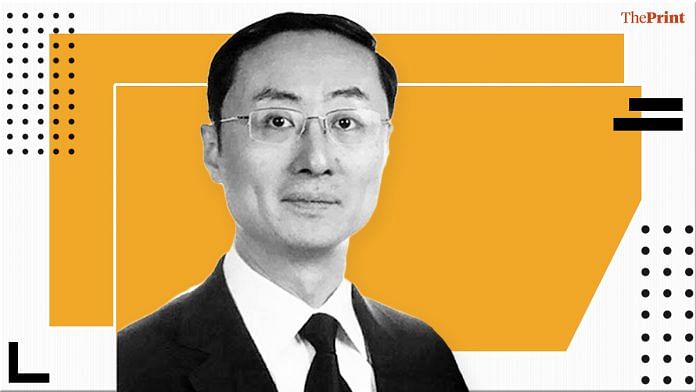New Delhi: China said Thursday that Indian and Chinese troops have disengaged at many parts along the Line of Actual Control (LAC) in Ladakh even as it reiterated its stand that the recent border tensions and the 15 June Galwan Valley clash were provoked by New Delhi.
Chinese ambassador to India Sun Weidong said temperatures are coming down at the tense border, and added that the two countries need each other for economic development.
He was addressing an event organised by the Delhi-based research body Institute of Chinese Studies (ICS), for which ThePrint was the media partner. The discussion was moderated by ICS director Ashok K. Kantha, who is former secretary in the Ministry of External Affairs and former Indian envoy to China.
Sun said the Galwan Valley clash, in which 20 Indian soldiers and an unconfirmed number of Chinese soldiers died, “was an unfortunate incident”. “Neither side wants to see it happen … With the joint efforts of both sides the border troops have disengaged on most localities, the situation on the ground is de-escalating and the temperature is coming down,” he added.
However, he blamed the clash on the Indian Army, saying it had violated the understanding reached at the first corps-commander-level meeting on 6 June.
The Galwan Valley clash — the deadliest confrontation between Indian and Chinese soldiers in four decades — occurred as the two sides attempted to disengage in light of the 6 June meeting, following tensions in Ladakh since May.
“The right and wrong of the Galwan valley incident is very clear and I must make it very clear that the responsibility is not on the Chinese side. In April this year, the Indian frontline troops were making roads and bridges and infrastructure like that along the Galwan Valley, and I think that also led to representations from the Chinese side through military and diplomatic channels,” Sun said.
After these representations, he added, “the Indian side agreed to withdraw its people and dismantle the infrastructure which was across the LAC and there was a meeting between corps commanders on 6 June… and Indian side committed that they will not cross the water mouth of the Galwan Valley to patrol or raise any infrastructure”.
Also Read: If India wants to tire China out on LAC, it must build fortresses at these pressure points
‘Indian soldiers attacked PLA troops’
The Galwan Valley clash took place when Indian troops “broke the consensus” reached during the meeting and “went across the LAC again” and “even violently attacked” Chinese soldiers.
Chinese troops, he said, always “exercise self-restraint and take the necessary steps to avoid an escalation”, but “we had to also defend ourselves”.
“That led to a very harsh clash or a physical clash between the two sides and that led to casualties,” he said, responding to a question on the number of Chinese soldiers that died in the clash.
Beijing is yet to confirm the number of Peoples Liberation Army (PLA) soldiers killed in the faceoff. Sun said the various interpretations going on at both sides, estimating the number of soldiers China lost in the clash, are “not helpful to ease the situation in the border areas”.
“We hope the Indian side will understand the goodwill from the Chinese side not to make the contradiction and also maintain peace and tranquillity along the border areas … We don’t want to add to more tensions in the Galwan Valley and the border areas,” he added.
Also Read: Navy deploys large number of ships in Indian Ocean to send clear ‘message’ to China
‘LAC is clear’
The LAC is “clear”, Sun said as he denied allegations that China triggered the recent border tensions by stepping into Indian territory. According to the ambassador, Chinese troops on the frontlines have known “these areas for many years and we also abide by those agreements we have signed”.
According to Kantha, the only way the LAC issue can be resolved is by not “compartmentalising” the boundary question.
“Over the past three decades, India and China have followed the policy of compartmentalising the boundary question and other outstanding issues and agreeing not to let them come in the way of development of their relations. It is clear that this policy has now run its course. Differences have turned into contentious discord and are adversely impacting the relationship. There is no wishing away this reality,” Kantha said.
Sun also stated that India’s real enemy is coronavirus and not China.
“Invisible virus rather than China is the threat. It is short-sighted and harmful to deny long history of peaceful co-existence between China and India and portray a friendly neighbour for thousands of years as opponent and strategic threat due to temporary differences and difficulties,” he said.
Also Read: India, China hold talks as Beijing’s ‘lack of cooperation’ slows Ladakh disengagement




The World knows that China is a liar and intruder in many Asian countries and in the Pacific Ocean as well. Pity is that other weaker countries just tow the Chinese line fearing retaliation. In India, our system is too soft on anti-national elements. We have forgotten how the British were ruthless against our freedom fighters and how they milked our own resources dry. Chinese are worse.
When Modi says China has not intruded it gives open opportunity to Kick Indian narrative even harder !!!!
Perhaps Modi was honest statesman but the media was lying. Ever consider that possibility?
If the LAC is so “clear” , why hasn’t China agreed even once to put its LAC on a map and present to India for discussions ? Why has that LAC kept changing over the decades ?
So what actually happened at the borders? Did China make an incursion or did India?
It is now uptu the Indian leadership to strongly reciprocate India’s stand.